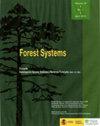Substrate properties, forest structure and climate influences wood-inhabiting fungal diversity in broadleaved and mixed forests from Northeastern Romania
IF 0.7
4区 农林科学
Q3 FORESTRY
引用次数: 2
Abstract
Aim of the study: The main objective of this study was to find the factors which best explains the wood-inhabiting fungal species’ richness in beech and oak-dominated forests.Area of study: We focused on broadleaved and mixed forests found in Northeastern Romania.Materials and methods: 59 plots were randomly set up in broadleaved and mixed forest stands, in which vegetation structure, composition, and topoclimatic factors were quantified along with wood-inhabiting fungal richness. Generalized linear models were used to characterize relationship between fungal diversity and biotic and abiotic factors.Main results: 374 taxa were identified, with numerous species found to cohabitate, the highest sharing being between Fine Woody Debris and Downed Coarse Woody Debris. The best predictors of total diversity were related to the substrate, management, stand structure, and macroclimate. Higher volumes of logs and large branches in various decay stages increased fungal richness. The same effect was found in diverse forests, with large snags. Macroclimate and topoclimate positively influenced diversity, through De Martonne Aridity Index and snow cover length, both indicating macrofungi preferences for higher moisture of substrate. Silvicultural interventions had an ambivalent effect to fungal diversity, phenomenon observed through stump numbers and proportion.Research highlights: Particular environmental characteristics proved significantly important in explaining different wood-inhabiting fungal richness patterns. Substrate-related variables were the most common ones found, but they were closely linked to climate and forest stand variables.Keywords: Wood-inhabiting fungi; oak, beech and coniferous forests; substrate diversity; dead wood types; coarse woody debris; fine woody debris; climatic variables.Abbreviations used:ALT, elevation; ASPI, Aspect Index; BIO1, mean annual temperature; BIO4, temperature seasonality; BIO7, annual temperature range; BIO12, annual precipitation; BIO15, precipitation seasonality; CWD, coarse woody debris; DBH, diameter at breast height; DCWD, downed coarse woody debris; DCWD_DECAY, DCWD decay diversity; DCWD_DIV, DCWD taxonomic diversity; DCWD_SV, surface-volume ratio of DCWD; DCWD_VOL, DCWD volume; DMAI, De Martonne Aridity Index; DMAI_AU, Autumn DMAI; DMAI_SP, Spring DMAI; DMAI_SU, Summer DMAI; DMAI_WI, Winter DMAI; FAI, Forestry Aridity Index; FWD, fine woody debris; L_SNAG_BA, large snag basal area; OLD_BA, basal area of old trees; POI, Positive Openness Index; RAI, Recent Activity Index; SCL, snow cover length; SLOPE, slope; SNAG_N, snag density; STUMP_N, stump density; TPI, Topographic Position Index; TREE_BA, mean basal area of trees; TREE_DIV, tree' Shannon diversity.基材性质、森林结构和气候对罗马尼亚东北部阔叶林和混交林木材真菌多样性的影响
研究目的:本研究的主要目的是寻找最能解释山毛榉和橡树为主的森林中栖息真菌物种丰富度的因素。研究领域:我们重点研究了罗马尼亚东北部的阔叶林和混交林。材料与方法:在阔叶林和混交林中随机设置59个样地,对样地的植被结构、组成、地形气候因子以及木本真菌丰富度进行量化。采用广义线性模型来描述真菌多样性与生物和非生物因素之间的关系。主要结果:共鉴定出374个分类群,其中有许多种共居,其中细木屑和落粗木屑的共享度最高。总多样性的最佳预测因子与基质、管理、林分结构和宏观气候有关。在不同的腐烂阶段,原木和大树枝的体积增加了真菌的丰富度。在不同的森林中也发现了同样的效果,有很大的障碍。宏观气候和地形气候通过De marton干旱指数和积雪长度正向影响多样性,两者都表明大型真菌偏好较高的基质湿度。造林干预对真菌多样性有矛盾的影响,这是通过树桩数量和比例观察到的现象。研究重点:特定的环境特征被证明在解释不同的木材真菌丰富度模式方面非常重要。与底物相关的变量是最常见的,但它们与气候和林分变量密切相关。关键词:木栖真菌;橡树、山毛榉和针叶林;底物多样性;枯木类型;粗木屑;细木屑;气候变量。所用缩写:ALT, elevation;ASPI,方面索引;BIO1,年平均气温;BIO4,温度季节性;BIO7,年温度范围;BIO12,年降水量;BIO15,降水季节性;CWD,粗木屑;胸径,胸高处直径;DCWD,倒下的粗木屑;DCWD_DECAY, DCWD衰变分集;DCWD_DIV, DCWD分类多样性;DCWD_SV: DCWD的表面体积比;DCWD_VOL, DCWD容积;德·马顿干旱指数;DMAI_AU,秋季DMAI;DMAI_SP, Spring DMAI;DMAI_SU,夏季DMAI;DMAI_WI,冬季DMAI;林业干旱指数;FWD,细木屑;L_SNAG_BA,大障碍基底面积;OLD_BA,古树基部面积;POI,正向开放指数;近期活动指数;SCL,积雪长度;斜坡,斜坡;SNAG_N,阻塞密度;STUMP_N,残桩密度;TPI,地形位置指数;TREE_BA,平均树基面积;树的香农多样性。
本文章由计算机程序翻译,如有差异,请以英文原文为准。
求助全文
约1分钟内获得全文
求助全文
来源期刊

Forest Systems
FORESTRY-
CiteScore
1.40
自引率
14.30%
发文量
30
审稿时长
6-12 weeks
期刊介绍:
Forest Systems is an international peer-reviewed journal. The main aim of Forest Systems is to integrate multidisciplinary research with forest management in complex systems with different social and ecological background
 求助内容:
求助内容: 应助结果提醒方式:
应助结果提醒方式:


